by Rachel Vilsack
October 2013
In 2011 the Bureau of Labor Statistics (BLS) released an updated education and training system to categorize what is needed to enter and become competent in an occupation. The system includes categories for education, experience, and training assignments, so each occupation may have up to three requirements for entering and attaining competency in the field. Some occupations may also require state-specific licensure, which is not included in these education and training classifications.
Figure 1 illustrates these categories and assignments. Each occupation is assigned to one of eight categories reflecting the typical level of education most workers need for that occupation. It is certainly the case that select employers require different levels of education in a specific occupation. One example is Registered Nurses. An associate degree is the minimum level of education required for this profession, but some employers may require a four-year degree. This can depend on industry sub-sector, like hospitals versus nursing homes, for example. This particular category is intended to illustrate the minimum level of education commonly required or the education needed as a prerequisite to obtaining the job.
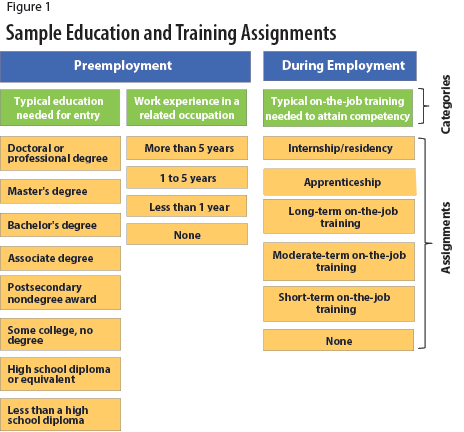
The related work experience category applies only to occupations in which experience is required or in which related experience is a commonly accepted substitute for formal education or training. Most occupations have "none" assigned. The on-the-job training category identifies any occupation-specific training on the job that is required of workers to acquire skills they need to become competent in a profession, including residencies, internships, and apprenticeships. This does not include any job-specific training that workers may receive from their employer as it may not transfer to another job.
Occupational assignments were determined, in part, by analyzing American Community Survey data from the U.S. Census Bureau. Economists looked at the educational attainment of workers in three categories: 18 to 29 years old, 30 years and older, and all workers in an occupation. Researchers also consulted the Occupational Information Network (O*NET). O*NET surveys workers and occupational experts on the education, work experience, and training needed for more than 800 jobs. Some occupations have more than one path to entry, so the categories which best described the path that most workers need was selected.
Figure 2 displays the distribution of Minnesota employment by BLS educational requirements using 2010 estimates and 2020 projections. By sheer numbers, jobs requiring a high school diploma or equivalent dominate employment in both 2010 and 2020.
While employment will increase among all educational categories between 2010 and 2020, the highest percentage growth will be among occupations requiring some college or a post-secondary non-degree award (33.6 percent), doctoral or professional degrees (18.4 percent), or master's degrees (17.2 percent).
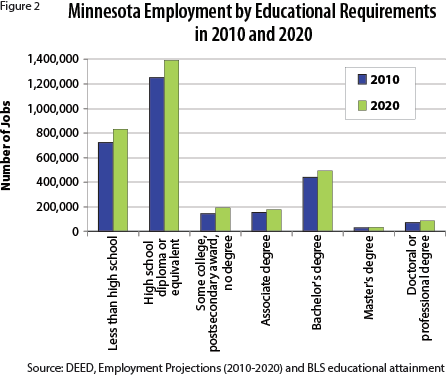
Of more than one million job openings projected between 2010 and 2020, 35.8 percent will be to new job creation. The remaining 64.2 percent of jobs will be open to replacement openings as people retire or otherwise leave their profession. Figure 3 shows the distribution of new jobs and replacement openings by BLS educational requirements. Over 291,000 job openings between 2010 and 2020 in Minnesota will require some post-secondary education. Nearly one in three new jobs projected to be created between 2010 and 2020, and 26.7 percent of replacement openings will require an education level beyond high school.
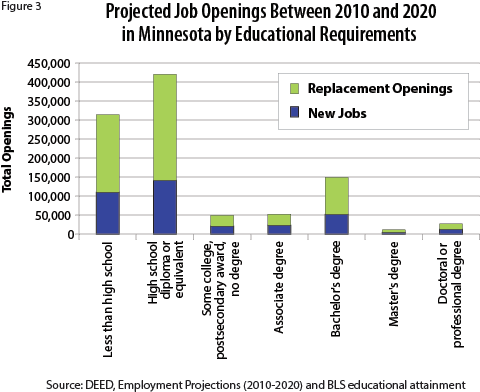
Table 1 provides a quick look at the current educational attainment for Minnesota's adult population 25 years of age and over. It appears to show an adequate number of degree-holders for future Minnesota jobs. This would assume, however, that all current degree-holders are working, will remain in the workforce until 2020, and have the skill sets and career interests to match the jobs available in Minnesota in 2020. This comparison of the educational needs of future jobs against the current educational attainment also excludes younger Minnesotans, ages 16 to 24, who may be in the workforce. We'd expect to see an increase in the population of no diploma holders and high school graduates in addition to the degree-holders who are younger than age 25.
| Table 1 | ||
|---|---|---|
| Projected Employment in 2020 and Current Educational Attainment for Minnesota Adults | ||
| Educational Level | Projected Employment, 2020 | Current Educational Attainment, MN 2012 |
| Less than high school | 833,577 | 270,170 |
| High school diploma or equivalent | 1,393,007 | 952,141 |
| Some college, postsecondary award, no degree | 165,367 | 801,498 |
| Associate degree | 176,690 | 381,595 |
| Bachelor's degree | 492,506 | 807,626 |
| Graduate degree | 119,470 | 387,714 |
| Source: DEED, Employment Projections,2010-2020, BLS educational attainment and U.S. Census Bureau, American Community Survey, 2012 | ||
Because the BLS system identifies the typical education needed to gain entry into an occupation field, it may not adequately take into account the education demanded from employers or across industry sectors. Take the example of a Registered Nurse again. While an Associate's degree is the minimum level of education required to gain entry into the field, some employers may require a four-year degree or more, depending on specialization. Therefore this analysis represents only the minimum educational needs for future Minnesota jobs.
Investigating the current education levels held by Minnesota workers in specific occupations could also shed light on the education levels needed for jobs. However these data are prone to issues of mal-employment, or incidences of highly educated workers in low skilled jobs. For example, an analysis of the educational attainment of workers in 2010 showed over 230,000 Minnesotans with a post-secondary education working in jobs that do not require post-secondary education as a prerequisite such as bartenders, food preparation workers, janitors, retail sales, customer service, and cashiers. Whether it's the choice of an individual to work in a job that does not utilize their educational attainment, a necessity during or after a recession, or a function of employer needs is not easily captured. With new 2012 data from the U.S. Census Bureau's American Community Survey recently available, we'll be better able to monitor the changes, if any, in the educational composition of workers in a market approaching economic recovery.
One immediate comparison that can be made between the BLS educational levels needed and those levels sought by employers is through job vacancy survey data. Minnesota's Job Vacancy Survey captures the minimum level of education required for jobs currently open for hire. As it stood during the second quarter of 2013, approximately 42 percent of Minnesota job vacancies required some form of post-secondary education. More specifically, 10 percent of job openings required vocational training, 7 percent required an Associate degree, 21 percent required a Bachelor degree, and 4 percent required an advanced or graduate degree.
Figure 4 displays the percent of job vacancies by educational attainment required for major occupational groups. Post-secondary education was required in nine out of 10 job vacancies in five occupational groups: life, physical and social science; legal; healthcare practitioners and technical; education, training, and library; and computer and mathematical. On the other end of the spectrum, less than one out of 10 job vacancies required post-secondary training in building and grounds cleaning, and maintenance; food preparation and serving; and farming, fishing, and forestry.
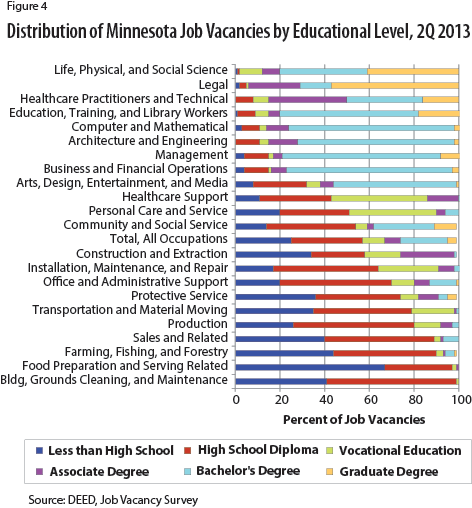
While the BLS educational requirements are available for 800 nationally defined occupations, there were only about 600 occupations with job openings reported by surveyed employers during the second quarter of 2013. Comparing this set of occupations and educational levels required under the BLS system and as demanded by employers with job openings reveals an interesting trend, displayed in Figure 5. The dominant education level required in over half (59.4 percent) of the occupations with job vacancies was the same level of education assigned under the BLS system.
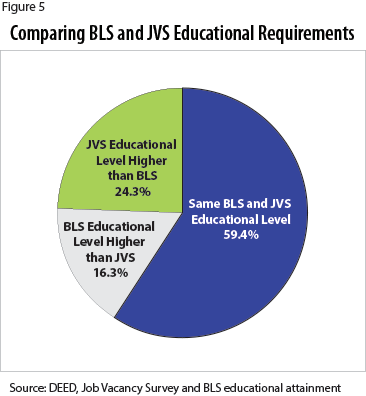
In 24.3 percent of occupations with job openings the majority had a minimum education level higher than the BLS-assigned level. In nearly half of the occupations – 57.2 percent – the BLS-assigned educational level was a high school diploma and employers with job openings required some form of post-secondary training. While 19.3 percent of the occupations had a BLS-assigned educational level of less than a high school diploma, the Minnesota employer was requiring at least a high school diploma.
Finally, in just over 16 percent of occupations the majority of job openings had a minimum educational level lower than the BLS-assigned levels. Among these occupations the most notable differences were that 36.1 percent of occupations had an employer identified education level of less than a high school diploma when the BLS-assigned education level was a high school diploma or equivalent, 22.7 percent required less than the BLS-assigned graduate degree level, 18.6 percent required less than the BLS-assigned Bachelor's degree, and 13.4 percent required less than the BLS-assigned some college/post-secondary award no degree.
One additional application for the occupation educational requirements is linking them to wages and comparing wages against those necessary to meet a basic needs budget. The hourly wages needed to meet a basic needs budget for a adult ($11.38) and for a single parent with one child ($17.51) in Minnesota were computed using the Family Wage and Budget Calculator by the JOBS NOW Coalition. This basic needs budget assumes a full-time work schedule and employer-provided health care. (Footnote 2)
Table 2 shows the percentage of Minnesota jobs in 2010, the start of the 10-year employment projections cycle, which offer a median wage needed to meet a basic needs budget for a single adult and a single parent. Only one in four Minnesota jobs requiring no diploma as a precondition for employment meets a basic needs budget for one adult, and less than five percent of jobs would sustain an adult and child. The percentages of jobs that could support an adult or a single parent with one child increase dramatically with higher educational requirement. (Footnote 3). All of the jobs requiring an Associate's degree or higher offer a median wage of $11.38 per hour or more and nearly nine in 10 jobs would support a single parent with one child.
While we can't assume what a basic needs budget will look like in 2020, this analysis illustrates an important point: The path to a self-sustaining, or family-sustaining, wage is a high school diploma or equivalent and beyond.
| Table 2 | ||
|---|---|---|
| Percentage of Minnesota Jobs by Educational Requirement that Meet a Basic Needs Budget | ||
| Educational Level | 1 Adult | 1 Adult, 1 Child |
| No diploma | 25.8% | 4.5% |
| High school diploma or equivalent | 95.4% | 59.6% |
| Some college, postsecondary award, no degree | 83.9% | 70.0% |
| Associate degree | 100.0% | 87.8% |
| Bachelor's degree | 100.0% | 97.2% |
| Graduate degree | 100.0% | 99.0% |
| Source: DEED Employment Projections, 2010-2020, BLS educational attainment, and JOBS NOW Coalition Family Wage and Budget Calculator | ||
In order to provide the best analysis of the education needed for future Minnesota jobs, more research must be conducted, particularly on the educational attainment levels of the current workforce and how those trends changed during the Great Recession and post-recession. We can further compare the level of education required by employers through DEED's job vacancy survey findings against the education of workers on the job. Results of these analyzes will be featured in a forthcoming Review supplement along with a proposed customization of the BLS-assigned education requirements for a more accurate measure of the training needed for Minnesota's future jobs.
1For the purposes of this analysis, jobs with a "post-secondary non-degree award" or "some college, no degree" educational category were combined into one category.
2The JOBS NOW Coalition Family Wage and Budget calculator can be found online.
3There are several jobs that require a post-secondary award, no degree, whose median hourly wages are just under the $11.38 per hour needed to meet the basic needs budget of an adult.